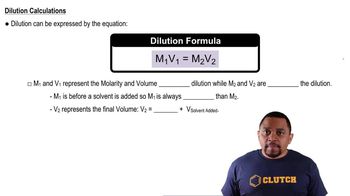Here are the essential concepts you must grasp in order to answer the question correctly.
Buffer Solutions
Buffer solutions are mixtures that resist changes in pH when small amounts of acid or base are added. They typically consist of a weak acid and its conjugate base or a weak base and its conjugate acid. In this case, formic acid (a weak acid) and sodium formate (its conjugate base) are used to create a buffer solution with a specific pH.
Recommended video:
Henderson-Hasselbalch Equation
The Henderson-Hasselbalch equation relates the pH of a buffer solution to the concentration of its acid and conjugate base. It is expressed as pH = pKa + log([A-]/[HA]), where pKa is the acid dissociation constant. This equation is essential for calculating the required concentrations of sodium formate and formic acid to achieve the desired pH.
Recommended video:
Henderson-Hasselbalch Equation
Molarity and Dilution
Molarity (M) is a measure of concentration defined as moles of solute per liter of solution. In this problem, the molarity of the formic acid solution is given, and understanding how to calculate the number of moles from this concentration is crucial. Additionally, the concept of dilution is important when preparing solutions to ensure the correct final concentrations are achieved.
Recommended video:
 Verified step by step guidance
Verified step by step guidance

